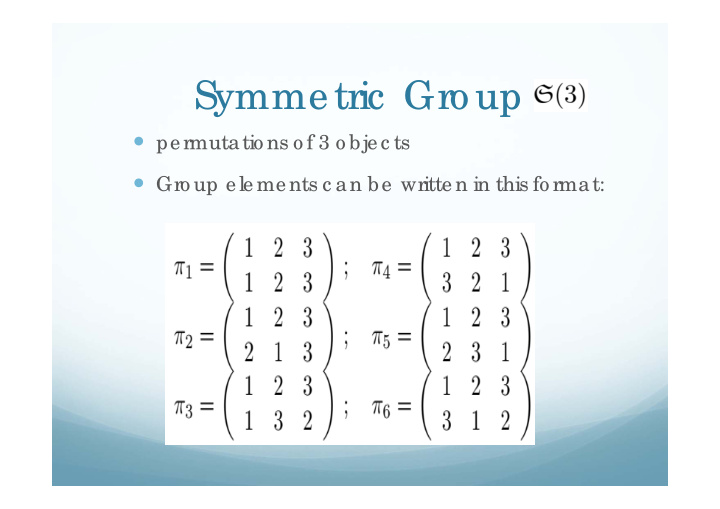



Symmetric Gro up pe rmutatio ns o f 3 o bje c ts Gro up elements c an be written in this fo rmat:
Symmetric Gro up No te
Symmetric group Product operation Is the group elements {e,a,b,ab,b,b 2 } isomorphic to the above permutation elements?
Symmetric group Order of , which is a symmetric group involving permutation of n objects, is n! is called symmetric group of degree n Subgroups of are called permutation groups Cayley’s theorem states that every finite group is isomorphic to a permutation group embedded inside Any permutation element can be equivalently represented as a product of disjoint permutation cycles
Symmetric group Consider the following permutation element This can be written in the following disjoint cycle structure Cycle decomposition is useful for multiplication of two permutation elements
Symmetric Gro up Two-cycle is called transposition . Inverse of the transposition is the same element. Inverse of 3-cycle (123) is (132). Why? Every n-cycle can be written as product of transpositions
Symmetric Gro up Note that the product of the two permutation elements have six-cycle structure. Of course the elements are different.
Symmetric Gro up Any k-cycle can be broken into products of transpositions (2-cycle) Depending on the odd or even number of transpositions, permutation element is called odd or even permutation
Symmetric group Any permutation element will have where where k runs from 1 to n such that All permutation elements with the above cycle structure can be shown to be conjugate elements ( prove) Total number of permutation elements( within the conjugacy class given by the cycle structure) is
Symmetric group The number of conjugacy classes in the symmetric group is equal to the number of ways of partitioning integer n For example, n=5 can be broken into 7 distinct conjugacy classes Convenient way of diagrammatically representing the conjugacy classes using Young diagrams 1-cycles by single box, 2-cycle by double vertical box and so on Identity element for n=5 is five 1-cycles denoted by
Symmetric group Product of two 2-cycles and one 1-cycle will be represented by One 5-cycle will be
Symmetric group Set of even permutation elements form a group known as alternating group Conjugate elements of even permutation elements will always be even which implies is an invariant or normal subgroup Factor group Show that there are only two cosets possible or the factor group has only two elements [e, (1,2)]
Direct Product groups For two groups, direct product group is Example Note that the elements of both the groups commute and order of G is product of order of the two groups
Semi-Direct product groups Let K be invariant subgroup of G and T be another subgroup of G such that identity element is the only common element between K and T Then, G is the semi-direct product group denoted by Show that T are coset elements Example
Symmetry of a molecule Rotations and reflections which leaves the molecule invariant Axis of rotational symmetry Plane of symmetry- two types Plane perpendicular to axis (horizontal mirror plane)- Plane containing the axis (vertical mirror plane)- Roto-reflection symmetry- There could be diagonal plane of symmetry (cube)-
Improper symmetry operations Mirror planes => h => mirror plane perpendicular to a principal axis of rotation v => mirror plane containing principal axis of rotation d => mirror plane bisects dihedral angle made by the principal axis of rotation and two adjacent C2 axes perpendicular to principal rotation axis
Rotoreflection Improper axis of rotation => S n rotation about n axis followed by reflection about the plane of symmetry (check it generates abelian group)
Point Groups The set containing elementary operations plus various symmetry operations as a result of composing elementary operations forms a group called Point group . At least one atom in the molecule is fixed under the symmetry operations- hence the name point group Number of elements in the point group is finite By Cayley’s theorem, point groups(symmetry of non- linear molecule) are isomorphic to subgroups of symmetry group
Schoenflies Notation
Water molecule Symmetry σ v ( xz ) C 2 Group symmetry is
Group symmetry? Ammonia Molecule
Methane symmetry? Group
Streographic projection
Streographic projection
Streographic projection
Streographic projection D2h D3 C3v C3
Symmetries of a cube
Embed tetrahedron in cube
Tetrahedral molecule C 2 Three C 2 C 3 Four 3-fold axes Pure Rotations give group T
a tetrahedral Structure has total 24 symmetry operations Including reflections σ is the mirror (reflection) plane S 4 is a rotation by 90 ° followed by a six mirror reflection planes (6 σ ) mirror reflection
Representation of
Recommend
More recommend